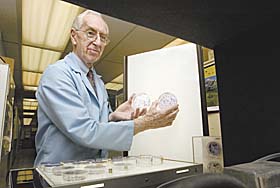  |
| HOME | THIS ISSUE | CALENDAR | GRANTS | BACK ISSUES | < BACK | NEXT > |
Research conducted 50 years ago set stage for modern cloningby Cindy Weiss - September 7, 2005 |
||||
|
Molecular and cell biology professor Philip Marcus in July celebrated the 50th anniversary of a landmark paper he co-authored in the July 1955 Proceedings of the National Academy of Sciences. The paper described a method developed by Marcus, then a 28-year-old graduate student, and his Ph.D. advisor, to grow colonies, or clones, from single mammalian cells. Their procedure was prompted by discussions with nuclear and biophysicist Leo Szilard, who is best known for his work on the nuclear chain reaction and the atomic bomb. This was the first practical and efficient method for growing colonies from individual animal cells, and it is still used today in laboratories around the world. Known as a “clonogenic assay,” it is often used in cancer research to isolate a few drug, virus, or radiation-resistant cells to study the molecular basis of the resistance. It differs from the cloning we now associate with animals, in which a nucleus from an animal cell is removed and used to create a new animal clone. Instead, it is the result of the asexual division of a cell that has been placed in a growth medium and allowed to divide on its own. Marcus and his advisor, Theodore T. Puck at the University of Colorado Medical Center in Denver, found that only a small percentage of the single mammalian cells successfully grew into colonies in the nutrient medium available at the time. Bacteriologists had been able to plate single cells for years, but microbiologists had been stymied by the lack of a method that worked well for animal cells. “Those were the early days of cell culture,” says Marcus. In 1954, Marcus had just moved to Puck’s lab in Colorado to begin Ph.D. studies after finishing his master’s degree at the University of Chicago, where he had worked in Szilard’s laboratory. When Szilard was visiting his former student in Colorado, Marcus described a problem he was having trying to get a high percentage of animal cells to clone from one starter cell. It was an inefficient process, yet it was easy to grow the cells by starting with a large number of them. “Don’t let the single cells know they’re alone,” Szilard suggested. This meant providing the same biochemical environment for a single cell that the mass culture had. “We came up with a concept whereby the mass culture of what was to become known as ‘feeder’ cells were at the bottom of a Petri dish, and the single cells would be separated physically from them, but they would still benefit from the environment conditioned by the feeder cells,” Marcus says.
Working with a machinist, Marcus made a plastic U-shaped platform, and cut microscope slides that would fit across it. He put the system together in an incubator on a Friday, using an established line of cervical cancer cells named HeLa, for their donor. When he came back on Saturday, “every place where I had deposited a single cell, there were now two cells.” By Sunday, there were four cells in every single-cell spot. Puck, his advisor, suggested that Marcus should prevent the cells in the bottom layer from dislodging and contaminating the top layer. He also advised using X-rays to inactivate reproduction in the feeder cells, to be sure that feeder cells were not contributing to the new cell colony. The first experiments using the new cloning procedure established for the first time the lethal dose of X-rays to a human cell. As a result, the Atomic Energy Commission lowered the radiation exposure guidelines for humans. It was soon learned that the feeder cells had two beneficial functions: They could supply nutrients the medium might lack, and absorb toxic materials in the medium. Eventually, with improvements in the growth medium, feeder cells were not necessary, although they are still used in stem cell research or in studies where it is otherwise difficult to produce clones from individual cells. Puck and Marcus published their first paper in July 1955. Szilard’s contribution was footnoted. Science historian Henry Harris has called the paper “the essential basis for what rapidly became the standard methodology for cloning animal cells.” Today Marcus is a Board of Trustees Distinguished Professor of Molecular and Cell Biology in the College of Liberal Arts and Sciences. He still teaches, conducts research and publishes papers, and is interim director of the Biotechnology/Bioservices Center. In recent years, his research has centered on interferon, a protein produced by animals that activates a cell’s anti-viral response. His most recent paper, published in March in the Journal of Virology, demonstrates a dual mechanism that the influenza virus has evolved to stop the production of interferon, and shows how widely different strains of influenza virus vary in their capacity to initiate interferon production. His laboratory currently is working on ways to control the spread of chicken influenza virus, to reduce the chances of a pandemic. |
| ADVANCE HOME UCONN HOME |

